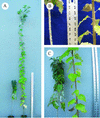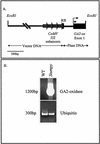Activation tagging of a dominant gibberellin catabolism gene (GA 2-oxidase) from poplar that regulates tree stature
- PMID: 12857810
- PMCID: PMC167068
- DOI: 10.1104/pp.103.020354
Activation tagging of a dominant gibberellin catabolism gene (GA 2-oxidase) from poplar that regulates tree stature
Abstract
We identified a dwarf transgenic hybrid poplar (Populus tremula x Populus alba) after screening of 627 independent activation-tagged transgenic lines in tissue culture, greenhouse, and field environments. The cause of the phenotype was a hyperactivated gene encoding GA 2-oxidase (GA2ox), the major gibberellin (GA) catabolic enzyme in plants. The mutation resulted from insertion of a strong transcriptional enhancer near the transcription start site. Overexpression of the poplar GA2ox gene (PtaGA2ox1) caused hyperaccumulation of mRNA transcripts, quantitative shifts in the spectrum of GAs, and similarity in phenotype to transgenic poplars that overexpress a bean (Phaseolus coccineus) GA2ox gene. The poplar PtaGA2ox1 sequence was most closely related to PsGA2ox2 from pea (Pisum sativum) and two poorly known GA2oxs from Arabidopsis (AtGA2ox4 and AtGA2ox5). The dwarf phenotype was reversible through gibberellic acid application to the shoot apex. Transgenic approaches to producing semidwarf trees for use in arboriculture, horticulture, and forestry could have significant economic and environmental benefits, including altered fiber and fruit production, greater ease of management, and reduced risk of spread in wild populations.
Figures





Similar articles
-
Roles of gibberellin catabolism and signaling in growth and physiological response to drought and short-day photoperiods in Populus trees.PLoS One. 2014 Jan 20;9(1):e86217. doi: 10.1371/journal.pone.0086217. eCollection 2014. PLoS One. 2014. PMID: 24465967 Free PMC article.
-
Green revolution trees: semidwarfism transgenes modify gibberellins, promote root growth, enhance morphological diversity, and reduce competitiveness in hybrid poplar.Plant Physiol. 2012 Oct;160(2):1130-44. doi: 10.1104/pp.112.200741. Epub 2012 Aug 17. Plant Physiol. 2012. PMID: 22904164 Free PMC article.
-
Cloning and overproduction of gibberellin 3-oxidase in hybrid aspen trees. Effects on gibberellin homeostasis and development.Plant Physiol. 2004 May;135(1):221-30. doi: 10.1104/pp.104.038935. Epub 2004 Apr 30. Plant Physiol. 2004. PMID: 15122019 Free PMC article.
-
Activation of gibberellin 2-oxidase 6 decreases active gibberellin levels and creates a dominant semi-dwarf phenotype in rice (Oryza sativa L.).J Genet Genomics. 2010 Jan;37(1):23-36. doi: 10.1016/S1673-8527(09)60022-9. J Genet Genomics. 2010. PMID: 20171575
-
Tissue-specific expression of Populus C19 GA 2-oxidases differentially regulate above- and below-ground biomass growth through control of bioactive GA concentrations.New Phytol. 2011 Nov;192(3):626-39. doi: 10.1111/j.1469-8137.2011.03837.x. Epub 2011 Aug 5. New Phytol. 2011. PMID: 21819406
Cited by
-
Dual Role of Gibberellin in Perennial Shoot Branching: Inhibition and Activation.Front Plant Sci. 2020 Jun 5;11:736. doi: 10.3389/fpls.2020.00736. eCollection 2020. Front Plant Sci. 2020. PMID: 32582259 Free PMC article.
-
Gibberellins regulate lateral root formation in Populus through interactions with auxin and other hormones.Plant Cell. 2010 Mar;22(3):623-39. doi: 10.1105/tpc.109.073239. Epub 2010 Mar 30. Plant Cell. 2010. PMID: 20354195 Free PMC article.
-
Phenome analysis in plant species using loss-of-function and gain-of-function mutants.Plant Cell Physiol. 2009 Jul;50(7):1215-31. doi: 10.1093/pcp/pcp078. Epub 2009 Jun 5. Plant Cell Physiol. 2009. PMID: 19502383 Free PMC article. Review.
-
Roles of gibberellin catabolism and signaling in growth and physiological response to drought and short-day photoperiods in Populus trees.PLoS One. 2014 Jan 20;9(1):e86217. doi: 10.1371/journal.pone.0086217. eCollection 2014. PLoS One. 2014. PMID: 24465967 Free PMC article.
-
Isolation and Role of PmRGL2 in GA-mediated Floral Bud Dormancy Release in Japanese Apricot (Prunus mume Siebold et Zucc.).Front Plant Sci. 2018 Jan 26;9:27. doi: 10.3389/fpls.2018.00027. eCollection 2018. Front Plant Sci. 2018. PMID: 29434610 Free PMC article.
References
-
- Atkinson C, Else M (2001) Understanding how rootstocks dwarf fruit trees. Compact Fruit Tree 34: 46–49
-
- Becker D, Kemper E, Masterson R (1992) New plant binary vectors with selectable markers located proximal to the left T-DNA border. Plant Mol Biol 20: 1195–1197 - PubMed
-
- Bradshaw HD, Ceulemans R, Davis J, Stettler R (2001) Emerging model systems in plant biology: poplar (Populus) as a model forest tree. J Plant Growth Regul 19: 306–313
-
- Bradshaw HD, Strauss SH (2001) Breeding strategies for the 21st century: domestication of poplar. In DI Dickman, JG Isebrands, JE Eckenwalder, J Richardson, eds, Poplar Culture in North America, Part B. NRC Research Press, Ottawa, pp 383–394
-
- Brutnell TP (2002) Transposon tagging in maize. Funct Integr Genomics 2: 4–12 - PubMed
Publication types
MeSH terms
Substances
LinkOut - more resources
Full Text Sources
Other Literature Sources
Miscellaneous

